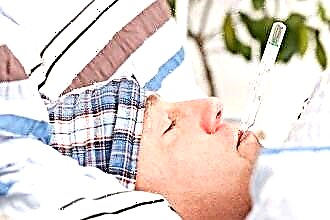Lymphoid tissue is part of the human immune system and protects the body from infectious and non-infectious factors. On the way of pathogenic microorganisms penetrating through the respiratory tract, there are tonsils and lymphoid follicles. A loose throat is a consequence of the struggle of lymphoid tissue with infectious microorganisms.
 To strengthen the forces to fight microbes, the follicles begin to increase in size, as a result of which the tissue becomes looser. Especially often, changes in the throat of a similar nature are noted in chronic infectious and inflammatory diseases (angina, pharyngitis).
To strengthen the forces to fight microbes, the follicles begin to increase in size, as a result of which the tissue becomes looser. Especially often, changes in the throat of a similar nature are noted in chronic infectious and inflammatory diseases (angina, pharyngitis).
In addition, it should be noted that frequent respiratory viral diseases also lead to lymphoid transformation. This applies to adenovirus, rhinovirus infection, influenza and parainfluenza. Regular attacks lead to the appearance of a chronic infectious focus, which is sometimes quite difficult to cope with.
ARVI
Periodic ARVI does not provoke irreversible transformation of lymphoid tissue. However, in immunosuppressive conditions, for example, after an infectious disease (tuberculosis, intestinal infection), with an exacerbation of a chronic disease, oncopathology, common colds occur with complications.
The infection is often transmitted by droplets by talking, sneezing or laughing from a sick person. It may take 3-4 days for symptoms to appear. The severity of clinical signs depends on the type of pathogenic microorganisms:
- adenovirus infection is manifested by profuse rhinorrhea, febrile hyperthermia, wet cough, and regional lymphadenitis. With the spread of infection and inflammation, signs of laryngitis, sinusitis and bronchitis join. Already at this stage, with pharyngoscopy, you can see a loose throat, swollen and reddened tonsils with fibrin bloom;
- MS infection is characterized by the appearance of cough, painful sensations when swallowing, subfebrile hyperthermia and paroxysmal cough, after which thick sputum is separated. The danger of the disease lies in the defeat of the bronchioles, which leads to the development of respiratory failure;
- the flu begins acutely with high fever, chills, and joint aches. A day later, rhinorrhea, soreness when swallowing, cough is gradually added, while hyperthermia persists, severe malaise, rapid fatigue and lack of appetite are worried. Often, complications of influenza are observed against the background of reduced immunity or with chronic tonsillitis, sinusitis or bronchitis;
A loose throat with frequent illnesses becomes a focus of infection, predisposing to the development of severe complications.
The most formidable complications are pneumonia, sepsis, otitis media, myocarditis, neuritis and false croup. Complications arise with inadequate treatment of viral pathology or due to secondary bacterial infection.
In diagnostics, pharyngo-, oto-, rhinoscopy, as well as radiography are used. In case of complications, consultation of highly specialized doctors (neurologist, pulmonologist) is required. From laboratory tests, RIF and PCR are used.
Tonsillitis
If angina is diagnosed 1-2 times a year, you should not be afraid of complications. However, with an increase in the frequency of acute tonsillitis to 4-5, one should beware of the development of a chronic form.
Frequent attacks of streptococcal microorganisms lead to the transformation of lymphoid tissue to keep the pathogen within the oropharynx. As a result, during pharyngoscopy, the so-called. Loose throat.
Chronic tonsillitis can take several forms, changing the severity and nature of clinical signs. Often, during the period of remission, a person can only be bothered by subfebrile hyperthermia (up to a maximum of 37.3 degrees), fatigue and drowsiness.
To exacerbate tonsillitis, hypothermia, drinking cold drinks, a cold, or a strong stress factor is enough. The formation of a chronic infectious focus is also facilitated by the curvature of the nasal septum, polynosis and adenoiditis, which disrupts nasal breathing.
 Clinically, exacerbation is manifested by pain when swallowing, talking, febrile hyperthermia, severe malaise and rapid fatigue. These symptoms are observed with a simple form of the disease. In more severe cases (with a toxic-allergic form), chest pain, arthralgia, renal dysfunction are worried and the risk of complications such as sepsis, rheumatism and collagenosis (scleroderma, lupus, vasculitis) increases.
Clinically, exacerbation is manifested by pain when swallowing, talking, febrile hyperthermia, severe malaise and rapid fatigue. These symptoms are observed with a simple form of the disease. In more severe cases (with a toxic-allergic form), chest pain, arthralgia, renal dysfunction are worried and the risk of complications such as sepsis, rheumatism and collagenosis (scleroderma, lupus, vasculitis) increases.
Diagnostics is based on the identification of pathogenic microorganisms using bacteriological analysis.
Pharyngitis
Changes in the lymphoid structures in the throat are often accompanied by chronic pharyngitis and sore throat. The reasons for the development of pharyngitis include:
- viral infection (parainfluenza, influenza, adenoviruses) - 70%;
- multiplication of bacteria (streptococci, staphylococci);
- fungal infection (candida, mold), observed against the background of prolonged antibiotic therapy, while taking hormonal and chemotherapy drugs;
- polluted air (industrial hazards, smog);
- chronic inflammation of the paranasal sinuses.
Based on the symptoms, it is not possible to establish the stage of chronic pharyngitis. A person may be bothered by tickling, dryness, a lump in the throat, thick mucus that is difficult to cough up, and weakness. Closely located lymph nodes become enlarged.
The picture with pharyngoscopy depends on the stage of the pathological process:
- the catarrhal form is characterized by redness, swelling and hypertrophy of the mucous membrane of the pharynx, uvula, arches, tonsils and palate. Mucus and enlarged follicles are noted on the surface;
- hypertrophic - characterized by hyperplasia and loosening of the lymphoid tissue;
- atrophic - manifested by dryness, thinning of the mucous membrane and the presence of crusts.
Therapeutic approach
To completely cure a loose throat, it is necessary to establish the cause of the development of the pathological condition. Given the variety of clinical symptoms, drugs are prescribed individually in each case. How to treat a loose throat in an adult?
| Procedure | Drug name | Action |
|---|---|---|
| Gargling | Miramistin, Furacilin, Chlorophyllipt, Givalex | Cleansing the mucous membrane of the pharynx from pathogenic microorganisms, reducing the severity of the inflammatory reaction, swelling and soreness. |
| Irrigation of the pharyngeal mucosa | Bioparox (for bacterial infection), Tantum-Verde, Strepsils Plus. | Fight against microbes of local action, analgesic and anti-inflammatory effect. |
| Sucking lozenges, tablets | Decatilen, Strepsils, Septolete, Faringosept | Local therapeutic action. |
| Lubrication of the pharyngeal mucosa | Lugol | Local therapeutic action. |
| Inhalation | Still alkaline mineral water, Rotokan, Lazolvan (for coughing) | Soothes the mucous membrane of the oropharynx, reduces irritation, mucus viscosity, inflammation, stimulates sputum discharge. |
Inhalation with herbal decoctions is not recommended for people with frequent allergies and bronchial asthma.
Of the drugs of systemic action, the following are prescribed:
- antipyretic (Nimesil);
- antiviral (Arbidol, Groprinozon, Otsilokoktsinum);
- antibacterial (Flemoklav, Cefotaxime);
- antihistamines (Loratadin, Suprastin, Zodak);
 vasoconstrictor (Lazolvan);
vasoconstrictor (Lazolvan);- herbal, homeopathic (Sinupret, Tonsillotren);
- expectorant drugs, mucolytics (Prospan, Gedelix, ACC);
- vitamins (Supradin, Aevit).
Don't forget about:
- bed rest;
- a complete, vitamin nutritious diet with a predominance of protein products;
- plentiful drinking regime (warm tea with raspberries, lemon, honey, fruit drinks, compotes);
- lack of contact with people suffering from infectious pathology;
- walks in the fresh air, dressing at the same time "according to the weather";
- reducing the time spent in public places.
Complex treatment avoids the chronicity of the pathological process. However, if subfebrile hyperthermia, malaise and rapid fatigue persist, surgical intervention can be performed. Its volume is established based on the results of instrumental diagnostics. In most cases, the infection persists in the tonsils, which requires a regular flushing by a doctor or tonsillectomy.

 vasoconstrictor (Lazolvan);
vasoconstrictor (Lazolvan);

